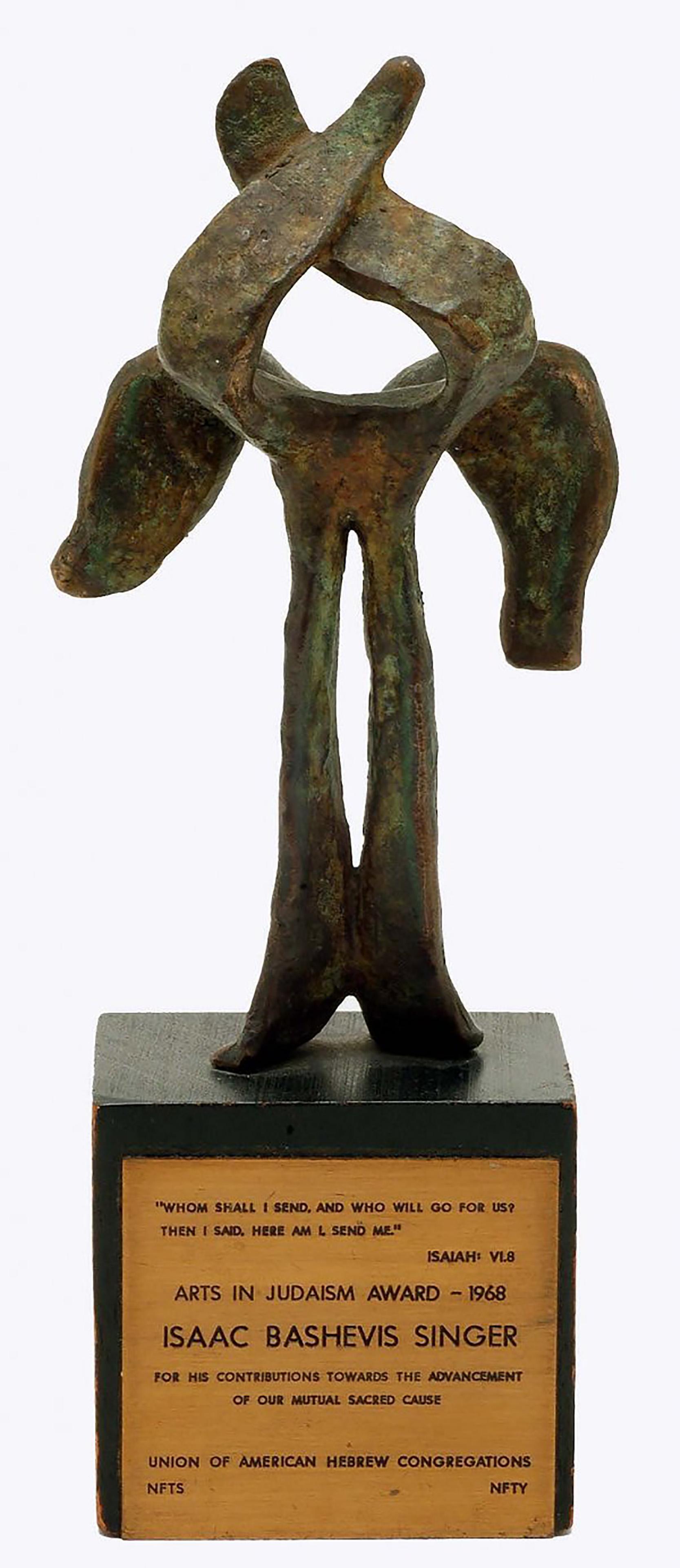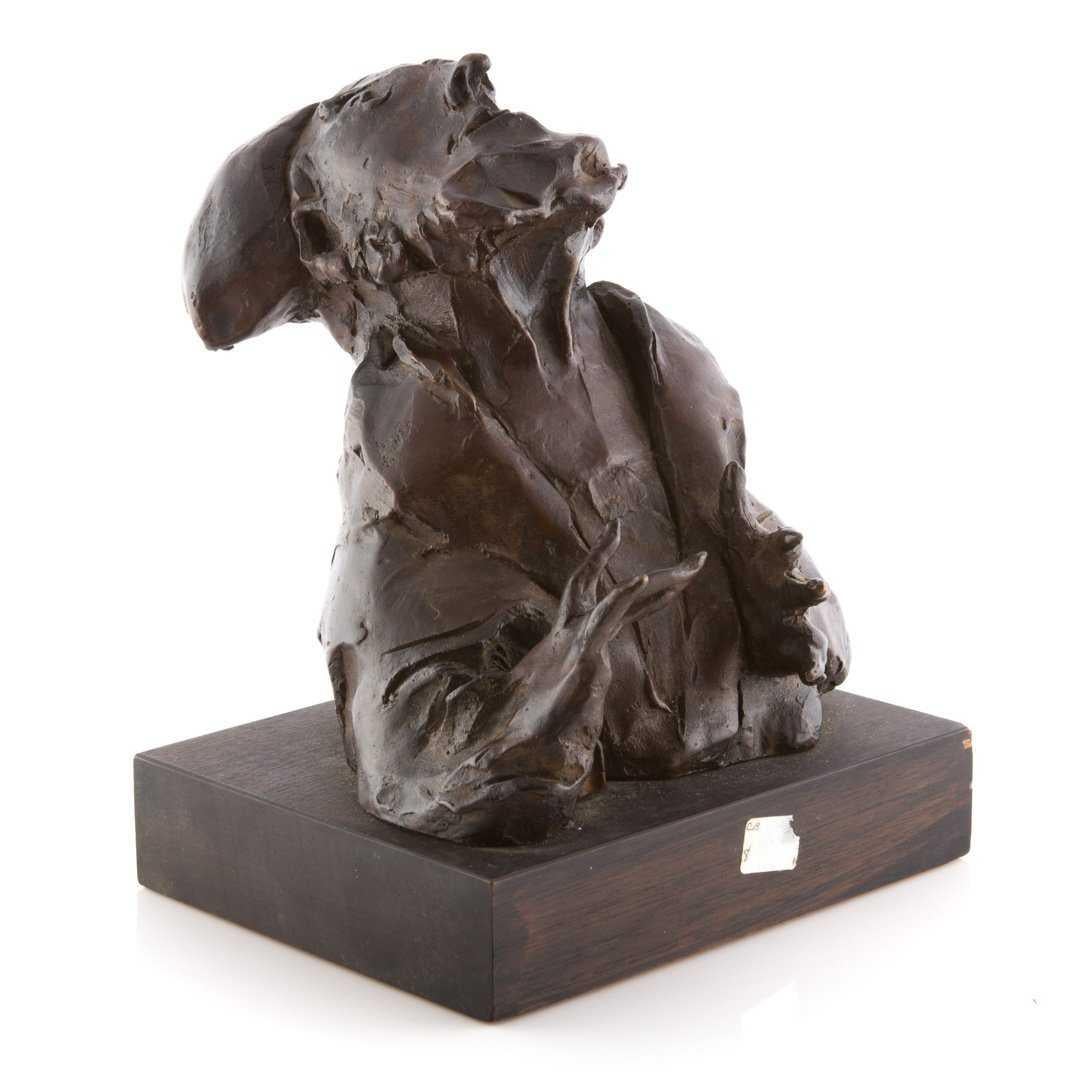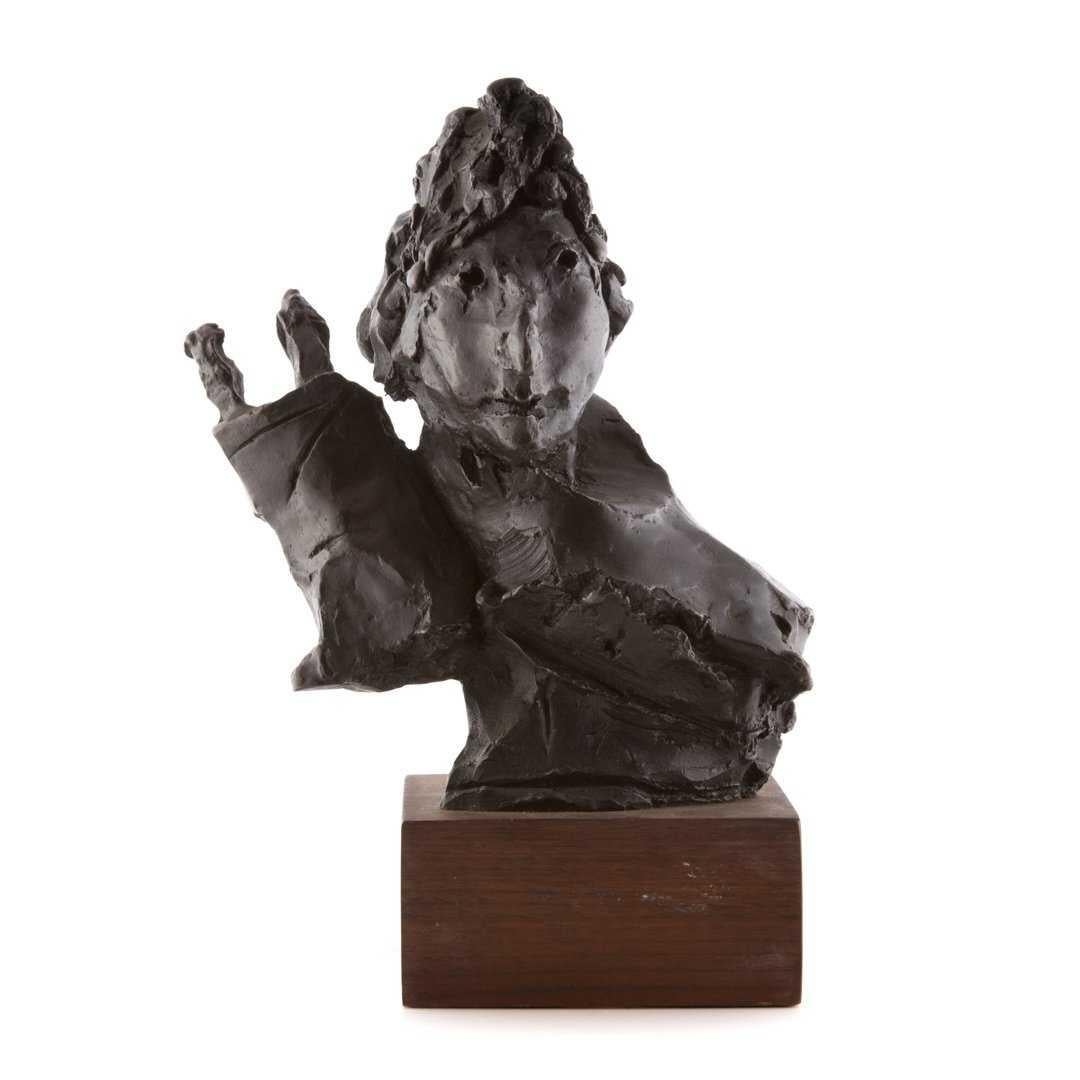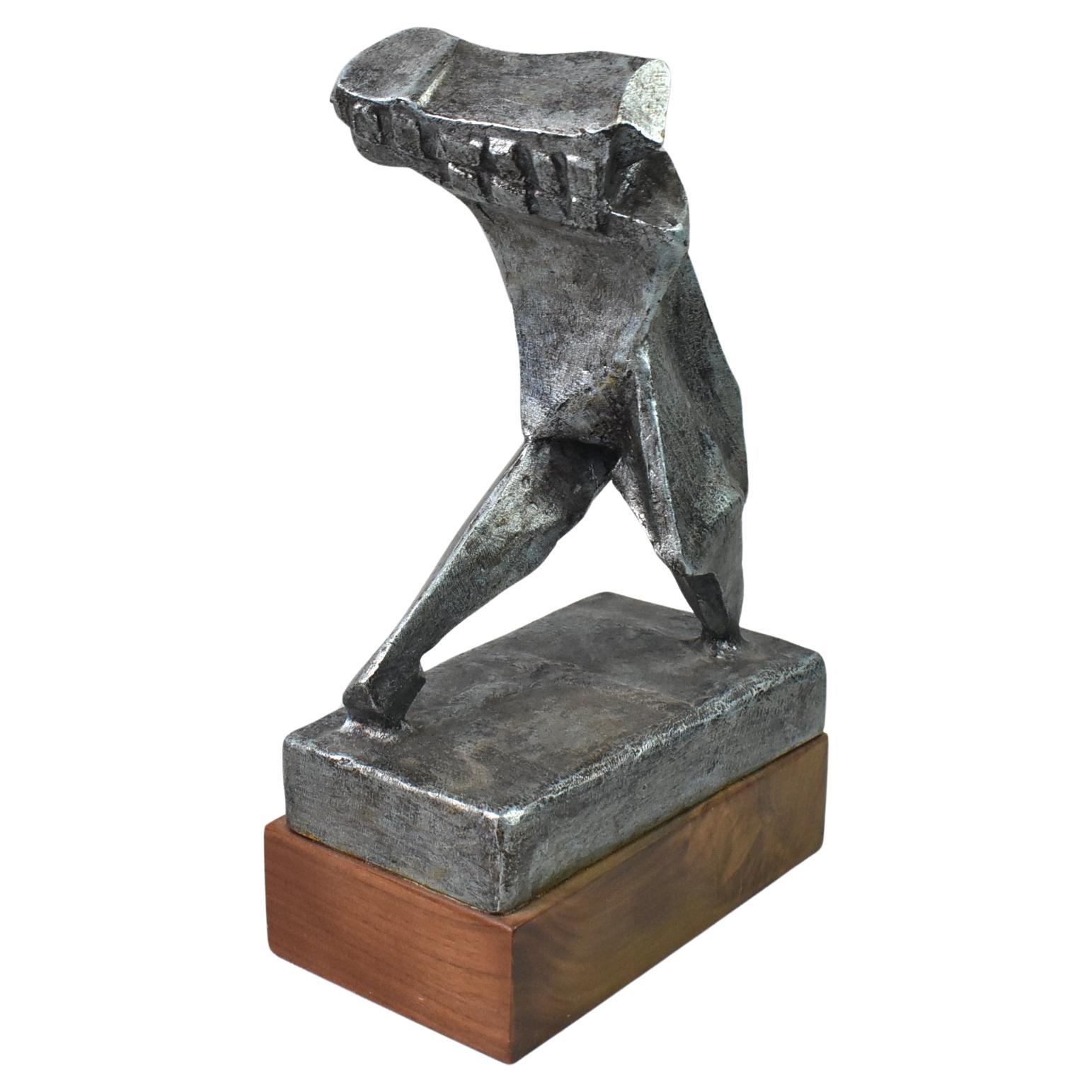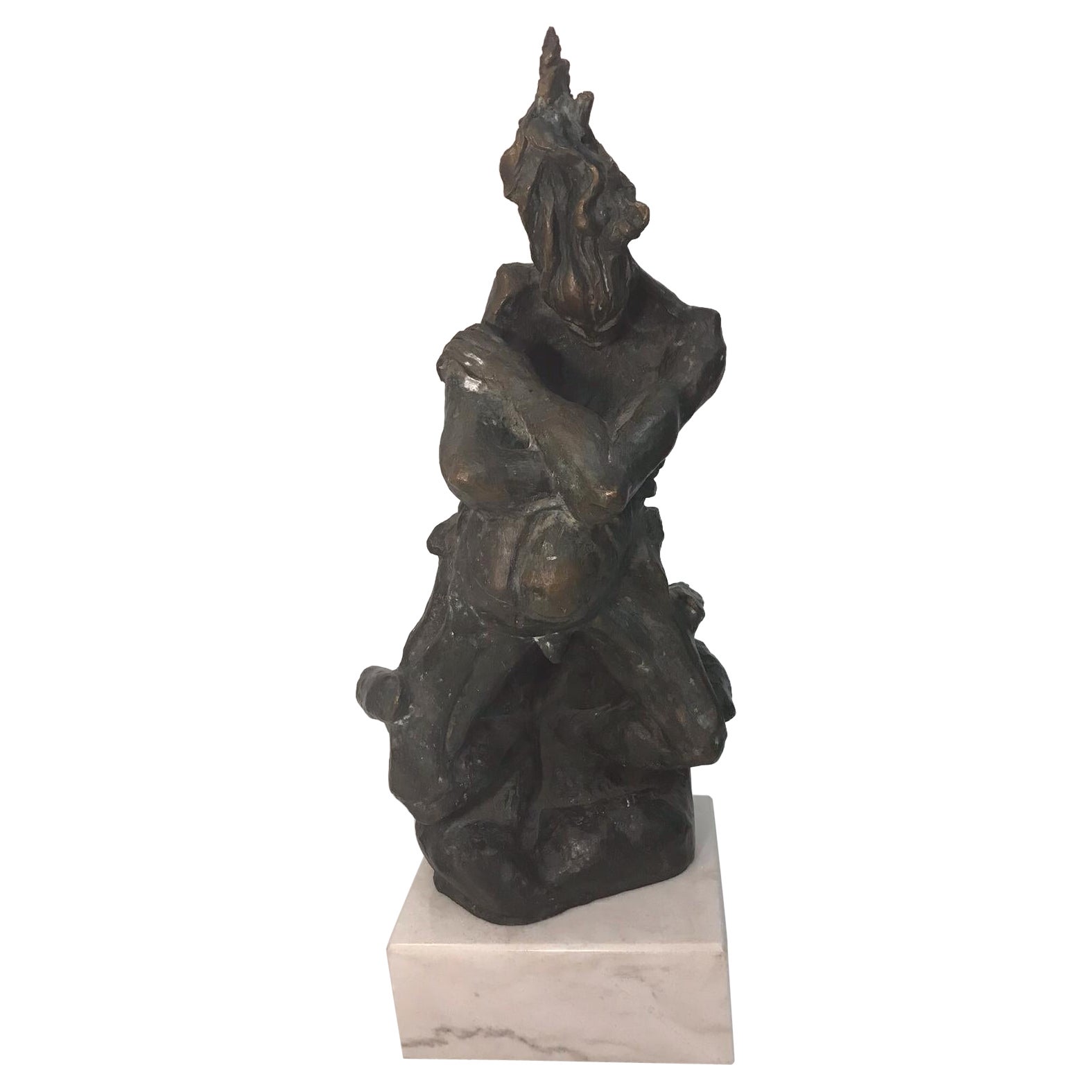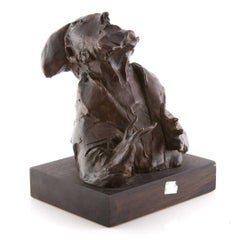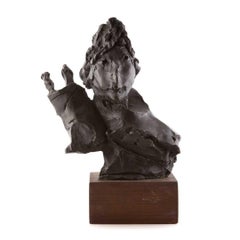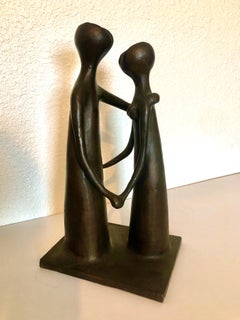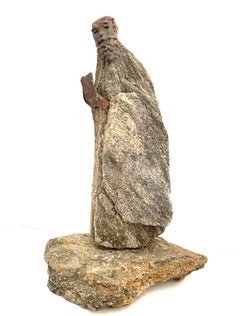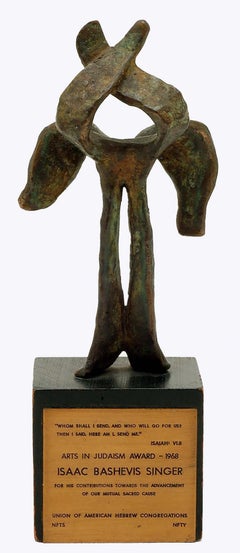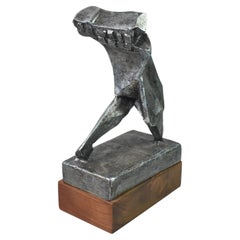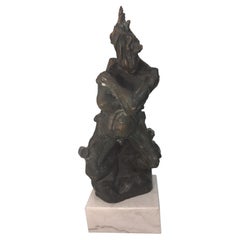Items Similar to Art Deco Expressionist Bronze Judaica Rabbi Sculpture Los Angeles Modernist
Want more images or videos?
Request additional images or videos from the seller
1 of 15
Peter KrasnowArt Deco Expressionist Bronze Judaica Rabbi Sculpture Los Angeles Modernistc.1930s
c.1930s
$7,500
£5,656.94
€6,533.82
CA$10,508.02
A$11,684.31
CHF 6,116.95
MX$142,726.05
NOK 76,865.48
SEK 72,307.39
DKK 48,774.51
About the Item
Bronze Jewish Rabbi. Original Patina. Art-deco wood carved base. It is signed with initials P.K. and marked "Calif Art Bronze Fdry LA" (California Art Bronze Foundry Los Angeles). it is not dated.
PETER KRASNOW (1886-1979), Russian-Ukrainian, American artist painter and sculptor, born Feivish Reisberg, was a California modernist and colorist artist known for his abstract wood sculptures and architectonic hard-edge paintings and drawings which were often based on Hebrew calligraphy and other subjects related to his Jewish heritage. Krasnow lived in Los Angeles for most of his life. Born in Novohrad-Volynskyi, Zawill, Ukraine, Krasnow immigrated to the United States in 1907, apprenticing with his father who was an interior decorator. He studied at the School of the Art Institute of Chicago graduating in 1916. While in New York exhibiting at the Whitney Club, he met photographer Edward Weston and began a lifelong friendship. Krasnow and his wife Rose drove cross-country in 1922 to settle in Los Angeles, where he quickly became part of a small but active art community. His notable peers included Weston, fellow artists Henrietta Shore, Stanton Macdonald-Wright, Lorser Feitelson, and Helen Lundeberg, and architects Rudolph Schindler and Richard Neutra. Other avant garde artists in Krasnow’s circle included Nick Brigante and Boris Deutsch. Krasnow’s early works, largely realist portraits and symbolic carved sculptures, are accomplished examples of social realism and Art Deco. In 1934, after a three-year stay in France, he spent the next decade carving abstract wood sculptures. By the mid-1940s he had returned to his easel, creating architectonic hard-edge paintings and drawings. His mature works dating from the 1950s through the 1970s were often abstract paintings based on Hebrew calligraphy and other subjects related to his Jewish heritage. His “Demountables” of the 1930s and 40s—hand-carved wood sculptures assembled from interlocking component parts—are organic abstractions drawing on traditions of folk and tribal art. His abstract paintings, whose bright, synthetic colors he chose to contrast with the dark political realities of the 1940s, are schematic tableaux that employ calligraphic symbols referencing spiritual ideas and organic processes. In both sculpture and painting, Krasnow developed styles that have surprising contemporary currency.
Select Notable Exhibits:
1974 Los Angeles Institute of Contemporary Art, Los Angeles, California:
Nine Senior Southern California Painters - Peter Krasnow, Nicholas Brigante, Lorser Feitelson, John McLaughlin, Florence Arnold, Helen Lundeberg, Emerson Woelffer, Han Burkhardt.
Peter Krasnow: Maverick Modernist Laguna Art Museum show of painting and sculpture curated by Michael Duncan, independent curator and corresponding editor of Art in America. Duncan has curated and co-curated over thirty exhibitions, most recently An Opening of the Field: Jess, Robert Duncan, and Their Circle, Crocker Art Museum, Sacramento, 2013 (awarded Best Thematic Exhibition Nationally by the International Association of Art Critics, United States); and LA RAW: Abject Expressionism in Los Angeles, 1945–1980, From Rico Lebrun to Paul McCarthy, Pasadena Museum of California Art, 2012.
His work was included in the inaugural exhibit at MOCA. He received a National Endowment for the Arts fellowship in 1977.
Peter Krasnow received a $7,500 fellowship from the National Endowment for the Arts in 1977 toward the end of his career.
Exhibitions
1922, Whitney Studio Club, New York
1922, Los Angeles County Museum of Art, Los Angeles
1923, MacDowell Club, Los Angeles (solo)
1926, The Print Rooms, Los Angeles
1927, Los Angeles County Museum of Art, Los Angeles
1927, Temple Emanu-El, San Francisco
1928, Oakland Municipal Art Gallery, Oakland (solo)
1928, Seattle Society of Fine Arts, Seattle (solo)
1928, Dalzell Hatfield Gallery, Los Angeles (solo)
1928, Zeitlin Bookstore, Los Angeles (solo)
1929, Scripps College, Claremont (solo)
1930, Stendahl Galleries, Los Angeles (solo)
1931, California Palace of Legion of Honor, San Francisco (solo)
1934, Galerie Pierre, Paris (solo)
1935, UCLA, Los Angeles
1935, The Print Rooms, Los Angeles
1935, California Pacific International Expo, San Diego
1939, Fine Arts Gallery, San Diego
1940, Stendahl Galleries, Los Angeles (solo)
1940, UCLA, Los Angeles
1954, Pasadena Art Institute, Pasadena
1964, Scripps College, Claremont (solo)
1975, Los Angeles Municipal Art Gallery, Los Angeles
1976, San Francisco Museum of Art, San Francisco
1977, Judah L. Magnes Museum, Berkeley
1978, Skirball Museum, Hebrew Union College, Los Angeles
1986, 1989, 1991, and 1993, Tobey C. Moss Gallery, Los Angeles
Artistic legacy
In 2000, the Laguna Art Museum acquired over 500 pieces of his work.
- Creator:Peter Krasnow (1886-1979, American)
- Creation Year:c.1930s
- Dimensions:Height: 17 in (43.18 cm)Width: 4.5 in (11.43 cm)Depth: 4.5 in (11.43 cm)
- Medium:
- Movement & Style:
- Period:
- Condition:good. minor wear to original base.
- Gallery Location:Surfside, FL
- Reference Number:1stDibs: LU38213878022
About the Seller
4.9
Platinum Seller
Premium sellers with a 4.7+ rating and 24-hour response times
Established in 1995
1stDibs seller since 2014
1,799 sales on 1stDibs
Typical response time: <1 hour
- ShippingRetrieving quote...Shipping from: Surfside, FL
- Return Policy
Authenticity Guarantee
In the unlikely event there’s an issue with an item’s authenticity, contact us within 1 year for a full refund. DetailsMoney-Back Guarantee
If your item is not as described, is damaged in transit, or does not arrive, contact us within 7 days for a full refund. Details24-Hour Cancellation
You have a 24-hour grace period in which to reconsider your purchase, with no questions asked.Vetted Professional Sellers
Our world-class sellers must adhere to strict standards for service and quality, maintaining the integrity of our listings.Price-Match Guarantee
If you find that a seller listed the same item for a lower price elsewhere, we’ll match it.Trusted Global Delivery
Our best-in-class carrier network provides specialized shipping options worldwide, including custom delivery.More From This Seller
View AllJudaica Bronze Sculpture "Rabbi" Figure Jewish American Boston Figural Modernist
By David Aronson
Located in Surfside, FL
Aronson, David 1923-
David Aronson, son of a rabbi, was born in Lithuania in 1923 and immigrated to America at the age of five. He settled in Boston, Massachusetts where he studied at the school of the Museum of Fine Arts under Karl Zerbe, a German painter well known in the early 1900s. Aronson later taught at the school of the Museum of Fine Arts for fourteen years and founded the School of Fine Art at Boston University where he is today a professor emeritus. An internationally renowned sculptor & painter, Aronson has won acclaim for his interpretation of themes from the Hebrew Talmud and Kabala. His best known works include bronze castings, encaustic paintings, and pastels. His work is included in many important public and private collections, and has been shown in several museum retrospectives around the country. He is considered to be one of the most important 20th century American artists.
At twenty-two David Aronson had his first one-man show at New York's Niveau Gallery. The next year, six of his Christological paintings were included in the Fourteen Americans exhibition at Manhattan's Museum of Modern Art where Aronson’s work was included alongside abstract expressionists Arshile Gorky, Robert Motherwell and Isamu Noguchi. In the 1950s, Aronson turned more toward his Jewish heritage for the inspiration for his art. Folklore as well as Kabalistic and other transcendental writings influenced his work greatly. The Golem (a legendary figure, brought to life by the Maharal of Prague out of clay to protect the Jewish community during times of persecution) and the Dybbuk (an evil spirit that lodges itself in the soul of a living person until exorcised) frequently appear in his work.
In the sixties, Aronson turned to sculpture. His work during this period is best exemplified by a magnificent 8’ x 4’ bronze door which now stands at the entrance to Frank Lloyd Wright's Johnson Foundation Conference Center for the Arts in Racine, Wisconsin. In the seventies and eighties, Aronson continued his work in pastel drawings, paintings, and sculptures, often exploring religion and the frailties of man's nature. During this time, in addition to a traveling retrospective exhibition and many one-man shows in New York, Los Angeles, Chicago, and Boston at the Pucker-Safrai Gallery on Newbury Street, Aronson won many awards and became a member of the National Academy of Design in New York. Two years ago he retired from teaching to work full-time in his studio in Sudbury, Massachusetts.
included in the catalog
Contemporary Religious Imagery in American Art
Catalog for an exhibition held at the Ringling Museum of Art, March 1-31, 1974.
Artists represented: David Aronson, Leonard Baskin, Max Beckmann, Hyman Bloom, Fernando Botero, Paul Cadmus, Marvin Cherney, Arthur G. Dove, Philip Evergood, Adolph Gottlieb, Jonah Kinigstein, Rico Lebrun, Jack Levine, Louise Nevelson, Barnett Newman, Abraham Rattner, Ben Shahn, Mark Tobey, Max Weber, William Zorach and others.
Selected Awards
1990, Certificate of Merit, National Academy of Design
1976, Purchase Prize, National Academy of Design
1976, Joseph Isidore Gold Medal, National Academy of Design
1976, Purchase Prize in Drawing, Albrecht Art Museum
1975, Isaac N. Maynard Prize for Painting, National Academy of Design
1973, Samuel F. B. Morse Gold Medal, National Academy of Design
1967, Purchase Prize, National Academy of Fine Arts
1967, Adolph and Clara Obrig Prize, National Academy of Design
1963, Gold Medal, Art Directors Club of Philadelphia
1961, 62, 63, Purchase Prize, National Institute of Arts and Letters
1960, John Siimon Guggenheim Fellowship
1958, Grant in Art, National Institute of Arts and Letters
1954, First Prize, Tupperware Annual Art Fund Award
1954, Grand Prize, Third Annual Boston Arts Festival
1953, Second Prize, Second Annual Boston Arts Festival
1952, Grand Prize, First Annual Boston Arts Festival
1946, Traveling Fellowship, School of the Museum of Fine Arts
1946, Purchase Prize, Virginia Museum of Fine Arts
1944, First Popular Prize, Institute of Contemporary Art
1944, First Judge's Prize, Institute of Contemporary Art
Selected Public Collections
Art Institute of Chicago
Virginia Museum of Fine Arts
Bryn Mawr College
Brandeis University
Tupperware Museum, Orlando, Florida
DeCordova Museum
Museum of Modern Art Print Collection, New York
Atlanta University
Atlanta Art...
Category
20th Century Expressionist Figurative Sculptures
Materials
Bronze
Bronze Sculpture Rabbi w Torah Judaica Figure American Boston Figural Modernist
By David Aronson
Located in Surfside, FL
Aronson, David 1923-
David Aronson, son of a rabbi, was born in Lithuania in 1923 and immigrated to America at the age of five. He settled in Boston, Massachusetts where he studied at the school of the Museum of Fine Arts under Karl Zerbe, a German painter well known in the early 1900s. Aronson later taught at the school of the Museum of Fine Arts for fourteen years and founded the School of Fine Art at Boston University where he is today a professor emeritus. An internationally renowned sculptor & painter, Aronson has won acclaim for his interpretation of themes from the Hebrew Talmud and Kabala. His best known works include bronze castings, encaustic paintings, and pastels. His work is included in many important public and private collections, and has been shown in several museum retrospectives around the country. He is considered to be one of the most important 20th century American artists.
At twenty-two David Aronson had his first one-man show at New York's Niveau Gallery. The next year, six of his Christological paintings were included in the Fourteen Americans exhibition at Manhattan's Museum of Modern Art where Aronson’s work was included alongside abstract expressionists Arshile Gorky, Robert Motherwell and Isamu Noguchi. In the 1950s, Aronson turned more toward his Jewish heritage for the inspiration for his art. Folklore as well as Kabalistic and other transcendental writings influenced his work greatly. The Golem (a legendary figure, brought to life by the Maharal of Prague out of clay to protect the Jewish community during times of persecution) and the Dybbuk (an evil spirit that lodges itself in the soul of a living person until exorcised) frequently appear in his work.
In the sixties, Aronson turned to sculpture. His work during this period is best exemplified by a magnificent 8’ x 4’ bronze door which now stands at the entrance to Frank Lloyd Wright's Johnson Foundation Conference Center for the Arts in Racine, Wisconsin. In the seventies and eighties, Aronson continued his work in pastel drawings, paintings, and sculptures, often exploring religion and the frailties of man's nature. During this time, in addition to a traveling retrospective exhibition and many one-man shows in New York, Los Angeles, Chicago, and Boston at the Pucker-Safrai Gallery on Newbury Street, Aronson won many awards and became a member of the National Academy of Design in New York. Two years ago he retired from teaching to work full-time in his studio in Sudbury, Massachusetts.
included in the catalog
Contemporary Religious Imagery in American Art
Catalog for an exhibition held at the Ringling Museum of Art, March 1-31, 1974.
Artists represented: David Aronson, Leonard Baskin, Max Beckmann, Hyman Bloom, Fernando Botero, Paul Cadmus, Marvin Cherney, Arthur G. Dove, Philip Evergood, Adolph Gottlieb, Jonah Kinigstein, Rico Lebrun, Jack Levine, Louise Nevelson, Barnett Newman, Abraham Rattner, Ben Shahn, Mark Tobey, Max Weber, William Zorach and others.
Selected Awards
1990, Certificate of Merit, National Academy of Design
1976, Purchase Prize, National Academy of Design
1976, Joseph Isidore Gold Medal, National Academy of Design
1976, Purchase Prize in Drawing, Albrecht Art Museum
1975, Isaac N. Maynard Prize for Painting, National Academy of Design
1973, Samuel F. B. Morse Gold Medal, National Academy of Design
1967, Purchase Prize, National Academy of Fine Arts
1967, Adolph and Clara Obrig Prize, National Academy of Design
1963, Gold Medal, Art Directors Club of Philadelphia
1961, 62, 63, Purchase Prize, National Institute of Arts and Letters
1960, John Siimon Guggenheim Fellowship
1958, Grant in Art, National Institute of Arts and Letters
1954, First Prize, Tupperware Annual Art Fund Award
1954, Grand Prize, Third Annual Boston Arts Festival
1953, Second Prize, Second Annual Boston Arts Festival
1952, Grand Prize, First Annual Boston Arts Festival
1946, Traveling Fellowship, School of the Museum of Fine Arts
1946, Purchase Prize, Virginia Museum of Fine Arts
1944, First Popular Prize, Institute of Contemporary Art
1944, First Judge's Prize, Institute of Contemporary Art
Selected Public Collections
Art Institute of Chicago
Virginia Museum of Fine Arts
Bryn Mawr College
Brandeis University
Tupperware Museum, Orlando, Florida
DeCordova Museum
Museum of Modern Art Print Collection, New York
Atlanta University
Atlanta Art...
Category
20th Century Expressionist Figurative Sculptures
Materials
Bronze
Israeli Bronze Sculpture Lovers Embrace Abstract Modernist Ein Hod Israel
By Gedalia Ben Zvi
Located in Surfside, FL
Bronze sculpture signed in Hebrew and numbered from small edition of 6
BIOGRAPHY
"I was born in Czechoslovakia in the year 1925, of traditional parents. I spent my youth partly in ...
Category
Mid-20th Century Modern Figurative Sculptures
Materials
Bronze
Polish Sculpture Granite Stone, Metal Judaica Jewish Holocaust Memorial Art
By Lubomir Tomaszewski
Located in Surfside, FL
Born in 1923, alumnus of the Warsaw Academy of Fine Arts. Student of the Warsaw University of Technology, is an extraordinary artist, searching for his own artistic way. Ambitious,...
Category
20th Century Modern Figurative Sculptures
Materials
Stone, Iron
Unknown Israeli Bronze
Located in Surfside, FL
Bronze figurative sculpture
Unknown Israeli Artist
Category
20th Century Figurative Sculptures
Materials
Bronze
Rare Vintage Israeli Judaica Rabbi Praying Mechanical Sculpture Frank Meisler
By Frank Meisler
Located in Surfside, FL
Rare Vintage unusual piece.
In this bronze or metal sculpture by Frank Meisler, the artist recreates a Rabbi at prayer. The figure seems cartoon-like with exaggerated facial features...
Category
1960s Folk Art Sculptures
Materials
Stone, Metal
You May Also Like
Bronze Sculpture to Isaac Bashevis Singer, Arts in Judaism Award signed Judaica
By Nathaniel Kaz
Located in New York, NY
Nathaniel Kaz
Bronze Sculpture to Isaac Bashevis Singer for Arts in Judaism Award, 1966
Bronze, Square wooden base, Metal tag
Signed and dated "66" to back of bronze portion of the w...
Category
1960s Abstract Expressionist Abstract Sculptures
Materials
Metal, Bronze
1980 Italy Bronze Abstract Sculpture by Pietro Perin Figura Figure
Located in Brescia, IT
This artwork was created by the Italian artist Piero Perin.
Piero Perin was born in 1924, in Cervarese, near Padua Italy. He lived and worked in Padova where he teached at the School...
Category
Late 20th Century Post-Modern Abstract Sculptures
Materials
Bronze
Carole Harrison Cast Bronze Abstract Sculpture
Located in Toledo, OH
Cast bronze abstract statue by Michigan artist Carole Harrison (1933-2022). 10 1/2" tall x 6 1/4" long x 3 1/2" deep. Marked on the base.
Carole Harrison (10/30/33 - 4/4/22) - Born...
Category
Late 20th Century North American Modern Abstract Sculptures
Materials
Bronze
Mounted Figural Bronze Sculpture by Elias Lifshitz
Located in North Miami, FL
This is an outstanding early bronze figural sculpture reminiscent of Henry Moore, executed by a lifelong sculptor Elias Lifshitz. "I am King of Creation"
Base only: 7 x 8.5, 3.5 in...
Category
Vintage 1960s American Brutalist Figurative Sculptures
Materials
Marble, Bronze
Art Deco Female Bronze Sculpture by Michael Shacham, 1977
Located in New York, NY
A beautiful and substantial signed and numbered female figurative gilt bronze sculpture on dark green, with white veining, marble base, by sculptor Michael Shacham...
Category
Late 20th Century American Art Deco Figurative Sculptures
Materials
Marble, Bronze
1985 Italy Bronze Abstract Sculpture by Edmondo Cirillo Front Opus
Located in Brescia, IT
This engagind and intense artwork was create in 1985 by the Italian artist Edmondo Cirillo. It was forged in bronze and then silver plated. The title of this piece is "Stele frontal...
Category
Late 20th Century Post-Modern Abstract Sculptures
Materials
Bronze
More Ways To Browse
Paris Art Bronze
L Art France Bronze
1930 Bronze Sculpture
Art Deco Los Angeles
Art Deco Cross
Art Deco Chicago
1930s Wood Sculpture
Moss Sculpture
Interlocking Sculpture
Modernist Wood Carved Sculpture
Currency Sculpture
Art Deco Jewish
Art Deco Painting Roses
Vintage Bookstore Signs
Lorser Feitelson
Richard Claremont
Rudolph Schindler
Paul Mccarthy Paintings
